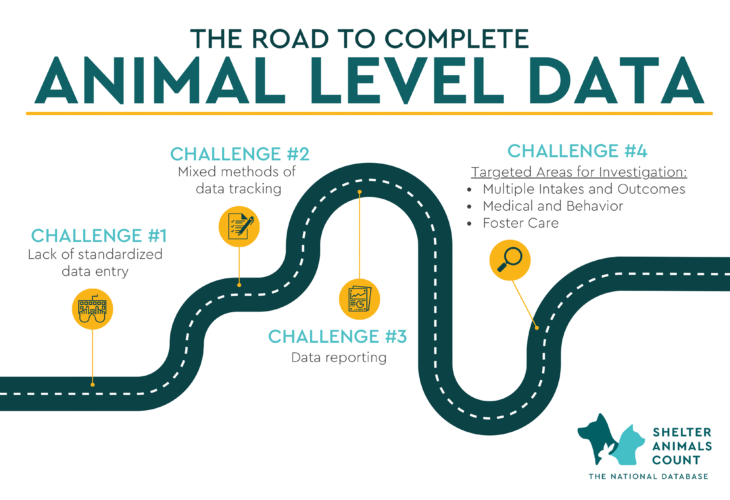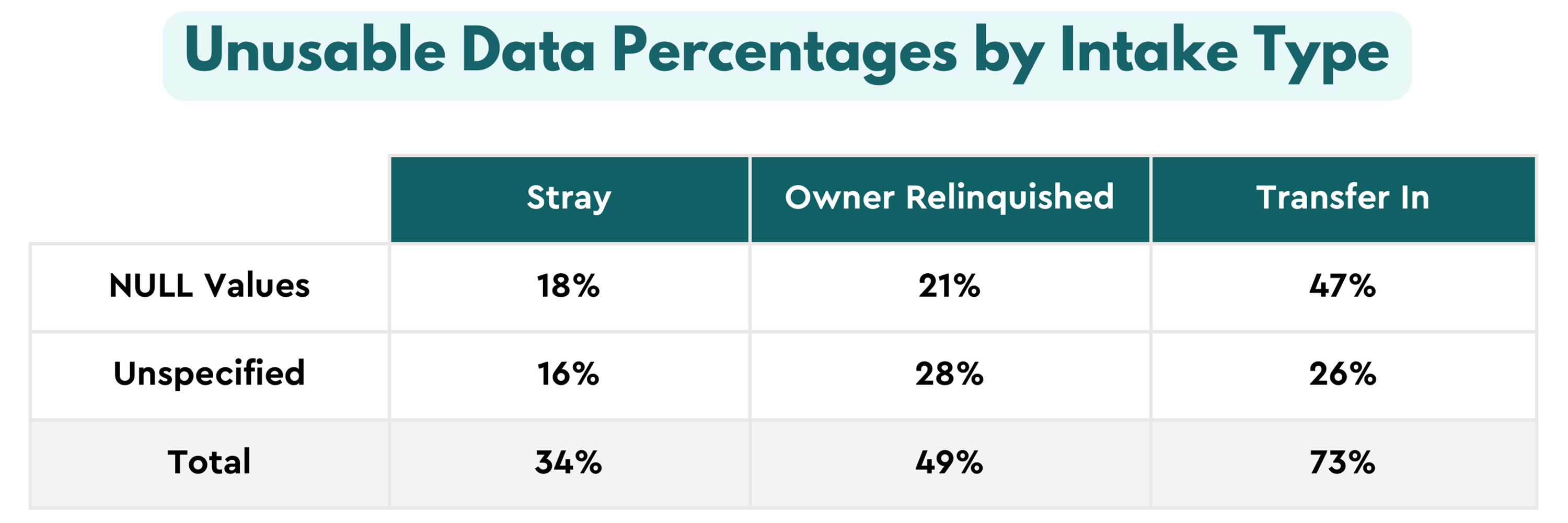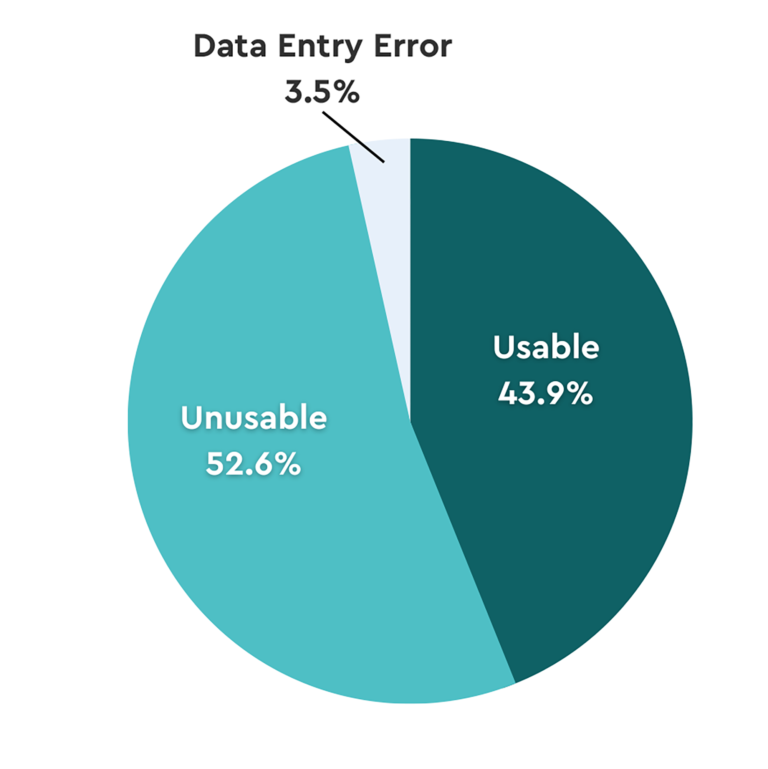Animal-Level Data Blog Series: Overcoming a lack of standardized data entry
- Home
- Animal-Level Data Blog Series: Overcoming a lack of standardized data entry

03Aug’23
ALD Blog Series: Overcoming a lack of standardized data entry
Exploring how various organizations report on intake subtypes
Since 2012, Shelter Animals Count (SAC) has been gathering information from shelters and rescues to find out how many animals are coming in and how many are leaving each year. This information, however, hasn’t been able to capture the why behind animals entering shelters, leaving many of us in animal welfare with more questions than answers. What are the most common reasons for surrendering a pet? Have changes in the economy led to more people giving up their pets, either from a lack of financial resources or lack of affordable pet-friendly housing?
To answer these questions, we must start digging into animal-level data (ALD). Animal-level data is simply all the data related to an individual animal, like their color, age, weight, and even reason for surrender or intake. Find a list of ALD fields in our animal welfare glossary.
Intake type tells us how an animal got to the shelter, but leaves out a critical piece of information: The reason why they needed to go to the shelter in the first place. This reason, catalogued by SAC as intake subtype, is intended to provide this level of detail.
A recent study by Tufts University showed that it’s important to have clear and consistent definitions for the information gathered about each animal in order to collect, analyze, and report it accurately on a national level.
Shelter Animals Count has already set industry standards for different intake types and outcomes, but in order to understand more about the why behind intakes and outcomes, animal traits and trends, we must tackle animal-level data. SAC is working on creating these standards by studying historical ALD and taking stock of how data is currently being collected by our animal welfare community.
Many of our initial findings from digging into intake subtypes confirmed previous concerns outlined in the 2 Year Animal Level Data Study White Paper. Amongst “Stray,” “Owner Surrender,” “Adoption Return” and “Transfer In” intake types, there was a whopping total of 2,720 unique subtypes. That’s a lot of different “whys!” While there were common themes amongst the subtypes, the terms used to describe them were naturally not the same from one shelter to another. Because we must have identical terms when aggregating data across shelters, it becomes nearly impossible to provide accurate ALD data. Reporting on each one of these unique subtypes would not provide the field with much useful insight.
We identified common themes among intake subtypes and manually sorted them into categories. Through this process, we discovered that there was a staggering amount of unusable data and data entry errors. (We will discuss data entry errors more in depth in the near future, but for the purposes of this blog post, SAC considers “unusable” to be subtypes that are too generic or too specific to be categorized by someone outside of the organization.)
For example, Intake: Stray with Subtype: Stray Cat is too generic, while Intake: Owner Surrender with Subtype: Mary Smith is too specific.
We recently looked at over 300,000 animal-level data records to better understand intake reasons for the 3 main intake types: Stray, Relinquished by Owner, and Transfer In. The table below details the percentages of unusable data due to either no entry (NULL Values) or too generic/too specific (Unspecified). Anywhere from 1/3 to 3/4 of intake reasons were unusable, depending on intake type:

The table above details the percentage of total unusable data by intake type. We looked at the three main intake types including Stray, Relinquished by Owner and Transfer In.

As you can see from the pie chart, combining intakes classified as Stray, Relinquished by Owner, Adoption Return and Transfer In shows us more than half of the data is unusable. At this stage, if SAC were to provide counts based on standardized categories, the data would be incomplete due to the volume of unusable information. In order to gain valuable insights into why animals are entering shelters, our industry must transform how data is being captured at the shelter/rescue level. Until then, these deeper-level insights will be incomplete at best, or at worse, grossly inaccurate.
With more usable subtype data, we can improve operational decision-making, uncover additional programming needs, make a stronger case for grant and major donor funding, and support changes in animal welfare legislation, housing, and insurance policies.
SAC recognizes that shelters often face significant barriers to be able to succinctly capture the why, including complex and overlapping reasons for surrender, software limitations, staff shortages/turnover, and more — the list could go on and on. However, in order to best serve the pets and people who count on us, we will have to modify our data entry habits.
What can your organization do right now to help close the missing data gap?
– Talk about the why with your teams and how critical this information is to help more pets and people
– If intake subtype (or the equivalent field) is not already a required field in your shelter management software (SMS), ask your provider to make it a required field for your shelter (or better yet, for all of their clients)
– If this is not possible, request your provider consider making this requirement a future development priority
– Review your policies and training protocols to require all intake staff/volunteers to select an intake subtype that captures at least one primary reason why the animal is in your care – even if your software does not (yet) require this field
Sponsored by Shelterluv and Life of Riley.
Categories
Archives
- May 2025(5)
- April 2025(1)
- March 2025(1)
- February 2025(6)
- December 2024(4)
- November 2024(2)
- October 2024(4)
- September 2024(3)
- August 2024(2)
- July 2024(3)
- June 2024(4)
- May 2024(5)
- April 2024(6)
- March 2024(6)
- February 2024(16)
- January 2024(10)
- December 2023(9)
- November 2023(5)
- October 2023(1)
- September 2023(8)
- August 2023(7)
- July 2023(3)
- June 2023(4)
- May 2023(3)
- April 2023(2)
- March 2023(8)
- February 2023(7)
- January 2023(9)
- December 2022(5)
- November 2022(3)
- October 2022(3)
- September 2022(7)
- August 2022(5)
- July 2022(5)
- June 2022(3)
- May 2022(3)
- April 2022(5)
- March 2022(6)
- February 2022(2)
- January 2022(2)
- December 2021(2)
- November 2021(3)
- October 2021(6)
- September 2021(3)
- August 2021(1)
- June 2021(1)
- October 2017(1)
- December 2015(1)
